In the past five years, China has developed a series of major innovative projects attracting world attention, including space satellites, large passenger jets, high-speed train network, aircraft carriers, bridges and much more. These ambitious programs ensure China will have a bright future.
BeiDou navigation system
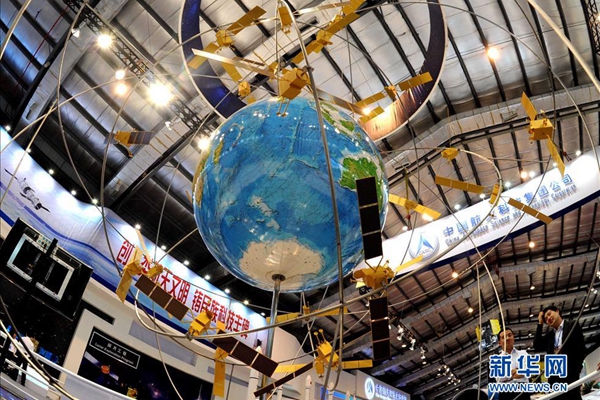
A model of the BeiDou Satellite Navigation system exhibited in Zhuhai. [File photo/Xinhua]
China will have its global GPS network based on the BeiDou Navigation Satellite System (BDS). Construction of the global network for the self-developed satellite navigation system will start during the remaining months of 2017 and will begin serving global customers upon completion in 2020.
C919 jet
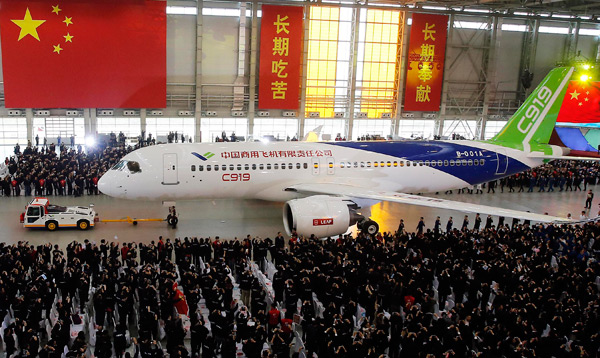
The C919 passenger jet was unveiled as it was rolled out from the final assembly line in Shanghai on Nov 2, 2015. [China Daily]
The C919 is a narrow-bodied twinjet airliner developed by Chinese aerospace manufacturer COMAC. The program was launched in 2008 and the plane first flew in May 2017. The self-developed aircraft, with completely independent intellectual property rights and 102 key technical breakthroughs, enabled China to break foreign manufacturers' monopoly in the big plane market.
"Heavenly Eye" telescope
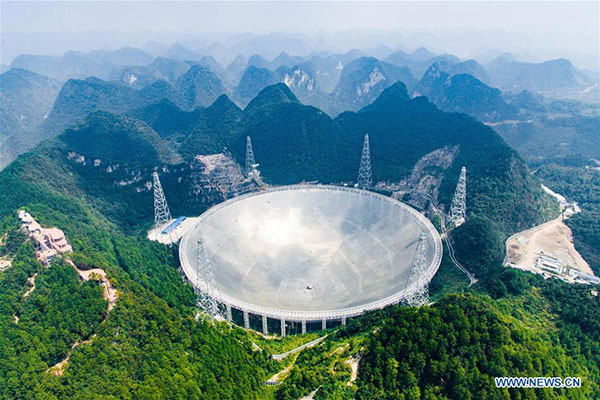
Photo taken on Sept 24, 2016 shows the 500-meter Aperture Spherical Telescope (FAST) in Pingtang county, Southwest China's Guizhou Province. [Photo/Xinhua]
The Five-hundred-meter Aperture Spherical Radio Telescope (FAST), nicknamed Tianyan ("Heavenly Eye"), is a major science project. It is a radio telescope located in a natural basin in Pingtang County of Guizhou Province in southwest China. It surpasses the existing telescopes of foreign countries in key areas, comprising a fixed 500m-diameter dish constructed in a natural depression in the landscape. It is the world's largest filled-aperture radio telescope, which will open people's eyes to the magnificent scenes of the universe.
Dark-matter satellite
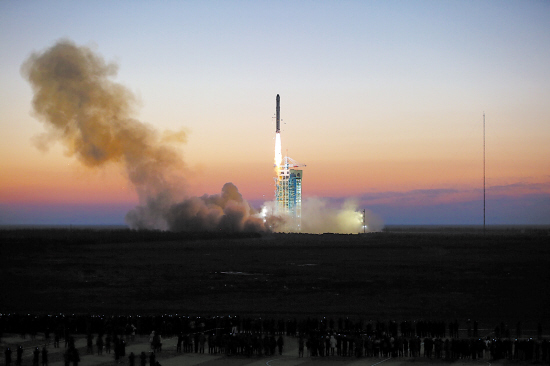
Carrier Long March 2-D rocket blasts off at the Jiuquan Satellite Launch Center in Gansu Province, Dec 17, 2015, sending into space the country's first Dark Matter Particle Explorer Satellite.[Photo/Xinhua]
The Dark Matter Particle Explorer (DAMPE) satellite "Wukong", which has been given this moniker after the Monkey King from the Chinese classic fantasy fiction "Journey to the West," will use its relatively large detection area to observe high volumes of cosmic rays, as well as establishing their source. It will survey the sky with sensitivity much greater than existing detectors.
World's first quantum communications satellite
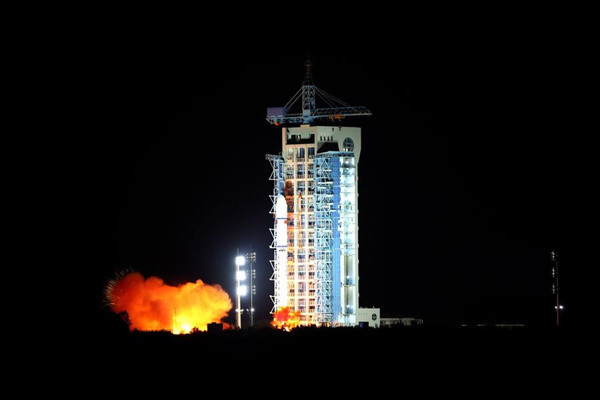
China successfully launched the world's first quantum satellite from the Jiuquan Satellite Launch Center in northwestern Gobi Desert. [Photo/Xinhua]
China has just launched the world's first quantum communications satellite, which is both an extreme test of the phenomena of quantum entanglement, and a technology tested for what could be the start of a global, hacker-free communications network. Officially known as the Quantum Experiments at Space Scale (QUESS), the mission has been nicknamed Mozi after the ancient Chinese philosopher said to be the first in history to conduct optical experiments.
China's first X-ray large space telescope
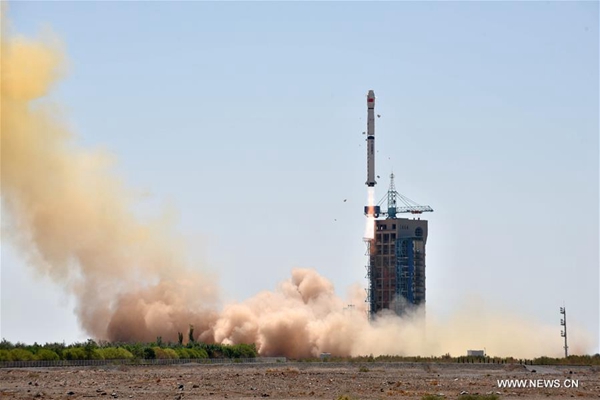
A Long March-4B rocket carrying X-ray space telescope to observe black holes, pulsars and gamma-ray bursts blasts off from Jiuquan Satellite Launch Center in northwest China's Gobi Desert, June 15, 2017. [Photo/Xinhua]
The Hard X-ray Modulation Telescope (HXMT) satellite, named Huiyan ("Insight"), carries three sets of detectors to collect high-energy X-rays. The main scientific objectives of HXMT are to scan the Galactic Plane to find new transient sources and to monitor the known variable sources, and to observe X-ray binaries so as to study the dynamics and emission mechanism in strong gravitational or magnetic fields. As China’s first X-ray large space telescope, it is expected to promote the country's high-energy astrophysics research to world's top level.
Space missions
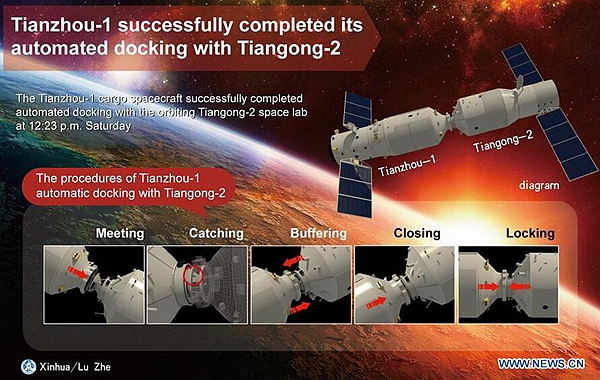
The graphics shows the procedures of Tianzhou-1 automated docking with Tiangong-2 on April 22, 2017. [Photo/Xinhua]
From Long March 5 to Long March 7, China's carrier rockets have been successfully upgraded. Shenzhou 11, part of the manned spaceflight element of the Shenzhou program, was launched in October 2016 as China's sixth manned space mission. It docked with the Tiangong 2 space laboratory. China has more space projects planned, including Chang'e 5, an unmanned Chinese lunar exploration mission, and the exploration of Mars.
High-speed rail
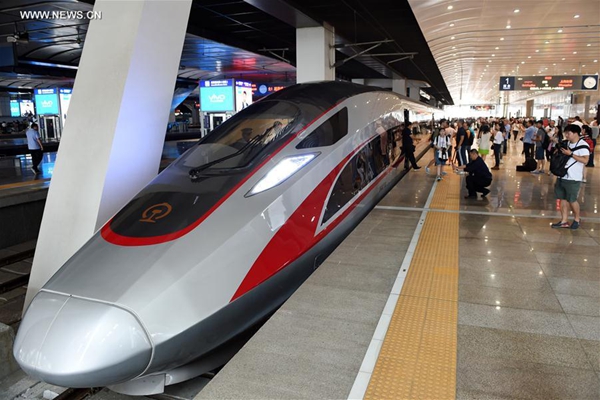
Photo taken on June 26, 2017 shows China's new bullet train "Fuxing" at Beijing South Railway Station in Beijing, capital of China. [Photo/Xinhua]
China has built the first high-speed rail line in the freezing high-altitude regions, as well as the first and only high-speed railway in a tropical zone in the world. The operational mileage of high-speed trains in China has now exceeded 22,000 kilometers, accounting for more than 60 percent of the global total. China's high-speed railways and trains have become a significant symbol of the world's railways modernization, and are a highly-appraised brand for Chinese high-end equipment.
World's longest desert freeway
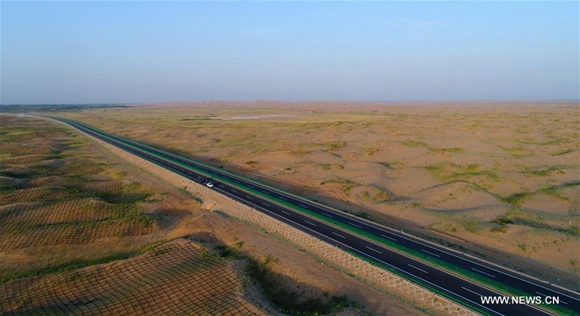
Photo taken on July 14, 2017 shows the Jingxin Expressway (G7) in Bayan Nur City, north China's Inner Mongolia Autonomous Region. The Jingxin Expressway links Beijing, capital of China, and Urumqi, capital of northwest China's Xinjiang Uygur Autonomous Region. [Photo/Xinhua]
Chinese engineers have completed the world's longest desert freeway. Measuring 930 kilometers in length and costing 37 billion yuan (US$5.5 billion), the freeway extends from Linhe in the Inner Mongolia Autonomous Region to Baigeda on the border of Inner Mongolia and Gansu Province. The four-lane freeway runs through the Gobi Desert and the Badain Jaran Desert. It is part of the 2,582-km Beijing-Xinjiang freeway. By the end of 2016, China had 131,000 km of freeways in operation, more than any other country.
World's longest cross-sea bridge
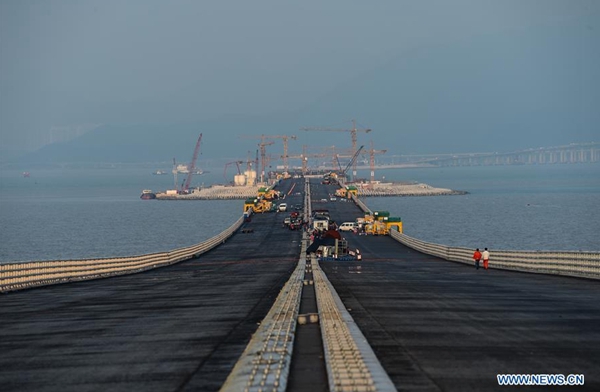
Photo taken on April 28, 2017 shows part of the Hong Kong-Zhuhai-Macao Bridge in Zhuhai, south China's Guangdong Province. [Photo/Xinhua]
The Hong Kong-Zhuhai-Macao Bridge is a great construction project comprising a series of bridges and tunnels crossing the Lingdingyang channel that will connect Hong Kong, Macao and Zhuhai, three major cities on the Pearl River Delta. It is the world's longest cross-sea bridge along with the world's longest sunken pipe tunnel. China also built other world-class cross-sea bridges such as Jiaxing-Shaoxing Sea Bridge and Qinglan Bridge.
World's fastest supercomputer
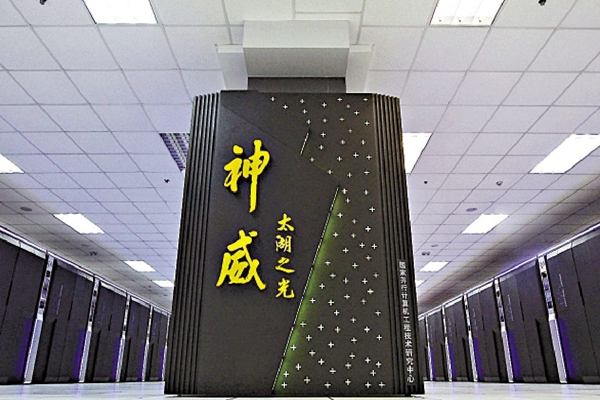
China's Sunway TaihuLight [File Photo]
The Sunway TaihuLight is a Chinese supercomputer ranked number one in the TOP500 list of the world's fastest supercomputer, with a stunning Linpack benchmark result of 93 petaflops. It was designed by the National Research Center of Parallel Computer Engineering & Technology (NRCPC) and is located at the National Supercomputing Center in the city of Wuxi, Jiangsu Province.
South-to-North water diversion
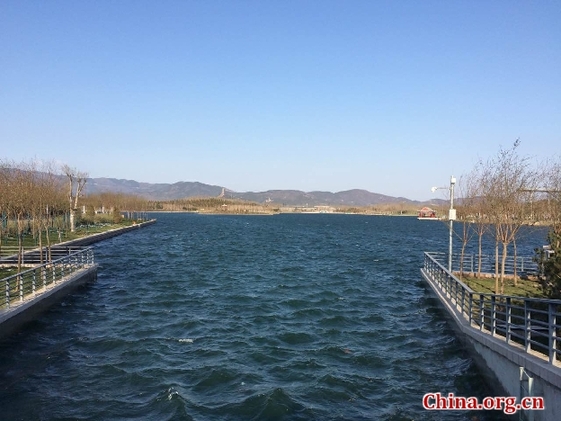
A section of the canal of the central route of China's South-to-North Water Diversion project in Beijing. [Photo by He Shan/China.org.cn]
The South-to-North Water Diversion Project is a multi-decade infrastructure mega-project aiming to channel 44.8 billion cubic meters of fresh water annually from the Yangtze River in southern China to the more arid and industrialized north. It is one of the most expensive engineering projects in the world and more than 100 million Chinese people have benefited from it.
Deep-sea submersible
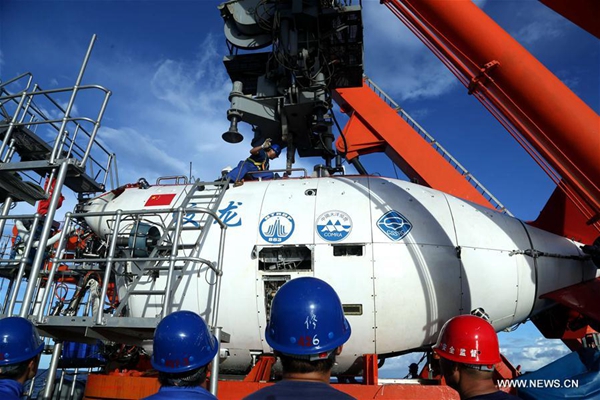
Working staff untie a cable on China's manned submersible Jiaolong after its dive in Yap Trench, June 11, 2017. [Photo/Xinhua]
Jiaolong, a Chinese self-designed manned deep-sea research submersible able to dive to a depth of over 7,000 meters, has the greatest depth range of any manned research vehicle in the world. Jiaolong can work in 99.8 percent of the world's oceans and has big significance in China's deep water exploration.
Aircraft carriers

Launch ceremony of China's first home-built aircraft carrier 001A in Dalian, Liaoning Province, on Apr. 26, 2017. [Photo/WeChat]
From Liaoning, China's first aircraft carrier involving the refit of a former Soviet aircraft carrier Varyag, to a fully self-developed aircraft carrier of indigenous Chinese design, it has only taken five years. China has thus caught up with the world superpowers in building aircraft carriers and will construct more for national security.
LNG carrier
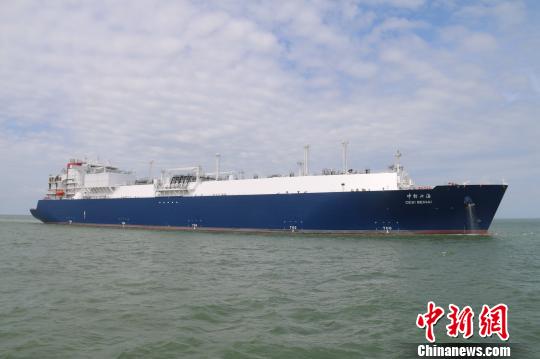
China's LNG Carrier Beihai. [Photo/Chinanews.com]
An LNG carrier is a specialized vessel designed for transporting liquefied natural gas (LNG). In order to facilitate the transport, natural gas is cooled down to approximately -163°C at atmospheric pressure, where the gas condenses into a liquid. The tanks on board an LNG carrier effectively function as giant thermoses to keep the liquid gas cold during storage. Such carrier ships are a crown jewel in the world shipbuilding industry; only China, the United States, Japan, South Korea and a few European countries managed to develop the technology so far.
Exploration of flammable ice
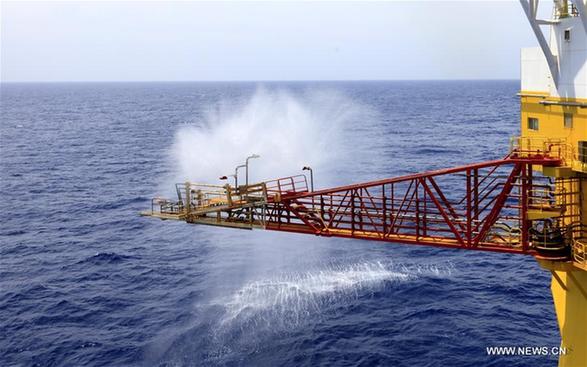
Photo taken on June 21, 2017 shows the trial mining site in the Shenhu area of the South China Sea. [Photo/Xinhua]
China completed trial exploration of flammable ice in the South China Sea, which extracted more than 300,000 cubic meters after a 60-day non-stop mining operation, exceeding previous expectations and setting world records in both the length and total amount of extraction. China began research in flammable ice in 1998, and found deposits in the South China Sea in 2007. A number of breakthroughs were made during the trial exploration, ranging from extraction methods to environmental protection. No environmental pollution or geological hazards occurred, which means there is a "China solution" for safe and green exploration of natural gas hydrate.

